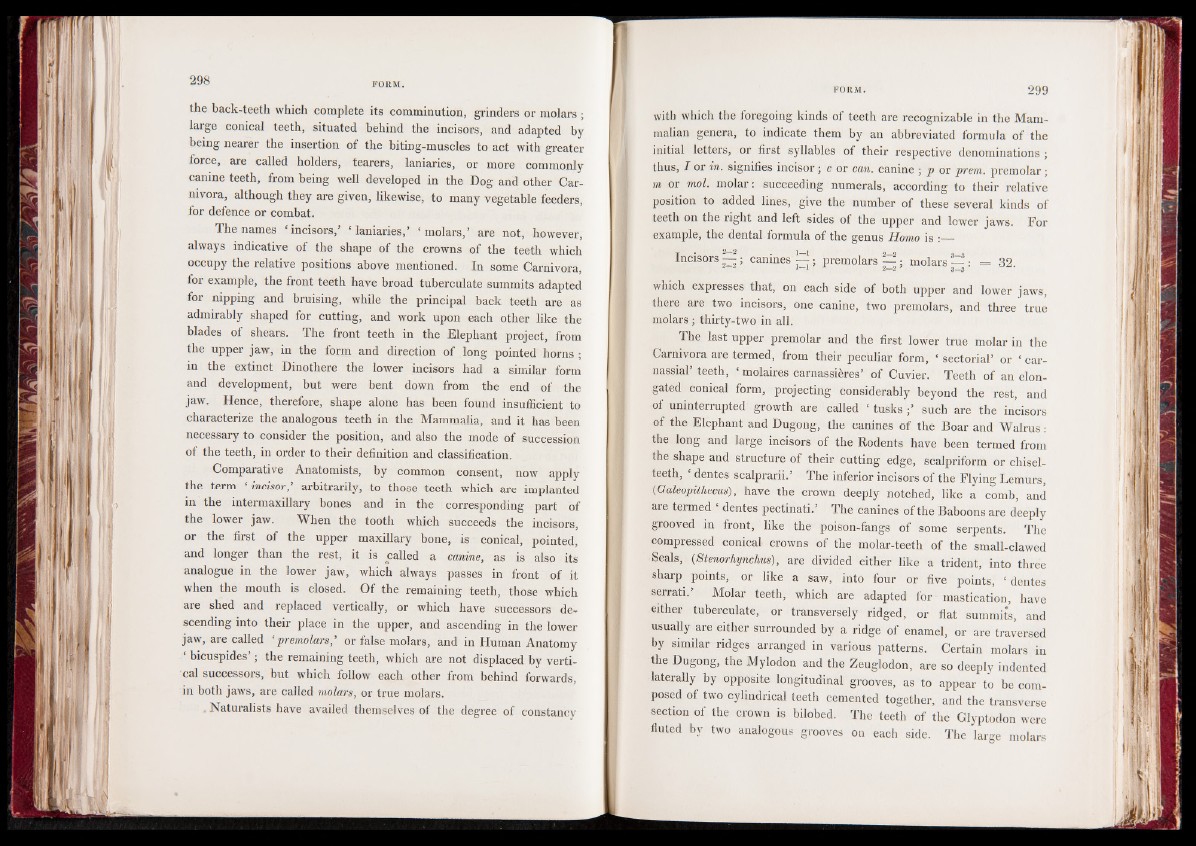
the back-teeth which complete its comminution, grinders or molars ;
large conical teeth, situated behind the incisors, and adapted by
being nearer the insertion of the biting-muscles to act with greater
force, are called holders, tearers, laniaries, or more commonly
canine teeth, from being well developed in the Dog and other Carnivora,
although they are given, likewise, to many vegetable feeders,
for defence or combat.
The names ‘incisors,’ ‘ laniaries,’ ‘molars,’ are not, however,
always indicative of the shape of the crowns of the teeth which
occupy the relative positions above mentioned. In some Carnivora,
for example, the front teeth have broad tuberculate summits adapted
for nipping and bruising, while the principal back teeth are as
admirably shaped for cutting, and work upon each other like the
blades of shears. The front teeth in the Elephant project, from
the upper jaw, in the form and direction of long pointed horns ;
in the extinct Dinothere the lower incisors had a similar form
and development, but were bent down from the end of the
jaw. Hence, therefore, shape alone has been found insufficient to
characterize the analogous teeth in the Mammalia, and it has been
necessary to consider the position, and also the mode of succession
of the teeth, in order to their definition and classification.
Comparative Anatomists, by common consent, now apply
the term ‘ incisor,’ arbitrarily, to those teeth which are implanted
in the intermaxillary bones and in the corresponding part of
the lower jaw. When the tooth which succeeds the incisors,
or the first of the upper maxillary bone, is conical, pointed,
and longer than the rest, it is called a canine, as is also its
analogue in the lower jaw, which always passes in front of it
when the mouth is closed. Of the remaining teeth, those which
are shed and replaced vertically, or which have successors descending
into their place in the upper, and ascending in the lower
jaw, are called ‘premolars,’ or false molars, and in Human Anatomy
‘ bicuspides’; the remaining teeth, which are not displaced by vertical
successors, but which follow each other from behind forwards,
in both jaws, are called molars, or true molars.
, Naturalists have availed themselves of the degree of constancy
with which the foregoing kinds of teeth are recognizable in the Mammalian
genera, to indicate them by an abbreviated formula of the
initial letters, or first syllables of their respective denominations ;
thus, I or in. signifies incisor ; c or can. canine ; p or prem. premolar ;
m or mol. molar : succeeding numerals, according to their relative
position to added lines, give the number of these several kinds of
teeth on the right and left sides of the upper and lower jaws. For
example, the dental formula of the genus Homo is :—
Incisors — ; canines j-j ; premolars ^ ; molars — : = 3 2 .
which expresses that, on each side of both upper and lower jaws,
there are two incisors, one canine, two premolars, and three true
molars ; thirty-two in all.
The last upper premolar and the first lower true molar in the
Carnivora are termed, from their peculiar form, ‘ sectorial’ or ‘ car-
nassial’ teeth, ‘ molaires carnassières’ of Cuvier. Teeth of an elongated
conical form, projecting considerably beyond the rest, and
of uninterrupted growth are called ‘ tusks ;’ such are the incisors
of the Elephant and Dugong, the canines of the Boar and Walrus :
the long and large incisors of the Rodents have been termed from
the shape and structure of their cutting edge, scalpriform or chisel-
teeth, ‘ dentes scalprarii.’ The inferior incisors of the Flying Lemurs,
(Galeopithecus), have the crown deeply notched, like a comb, and
are termed ‘ dentes pectinati.’ The canines of the Baboons are deeply
grooved in front, like the poison-fangs of some serpents. The
compressed conical crowns of the molar-teeth of the small-clawed
Seals, (Stenorhynchus), are divided either like a trident, into three
sharp points, or like a saw, into four or five points, ‘ dentes
serrati.’ Molar teeth, which are adapted for mastication, have
either tuberculate, or transversely ridged, or flat summits, and
usually are either surrounded by a ridge of enamel, or are traversed
by similar ridges arranged in various patterns. Certain molars in
the Dugong, the Mylodon and the Zeuglodon, are so deeply indented
laterally by opposite longitudinal grooves, as to appear to be composed
of two cylindrical teeth cemented together, and the transverse
section of the crown is bilobed. The teeth of the Glyptodon were
fluted by two analogous grooves on each side. The large molars